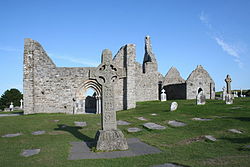Cluain Mhic Nóis | |
 Cross of the Scriptures, Cathedral, Temple Doolin and South Cross | |
| Monastery information | |
|---|---|
| Other names | Cluain-maccu-nois; Cluain-mic-nois; Cluan; Tipraic, with Eaglais-beaag |
| Order | Canons Regular of Saint Augustine (1140–c.1144) Augustinian Canons Regular – Arroasian (1144–1568) |
| Established | AD 544 |
| Disestablished | 1568 |
| Mother house | Clonard Abbey (mother house of nunnery only) |
| Diocese | Diocese of Clonmacnoise |
| People | |
| Founder(s) | St. Ciarán |
| Architecture | |
| Style | Celtic monastic |
| Site | |
| Location | near Athlone, County Offaly, Ireland |
| Coordinates | 53°19′26″N 7°59′28″W / 53.32389°N 7.99111°W |
| Visible remains | cathedral, seven churches, two round towers, three high crosses, grave slabs |
| Public access | yes |
| Website | http://www.heritageireland.ie/en/midlands-eastcoast/clonmacnoise/ |
| Official name | Clonmacnoise |
| Reference no. | 81, 250, 601[1] |

Clonmacnoise (Irish: Cluain Mhic Nóis) is a ruined monastery situated in County Offaly in Ireland on the River Shannon south of Athlone, founded in 544 by Saint Ciarán, a young man from Rathcroghan, County Roscommon.[2] Until the 9th century it had close associations with the kings of Connacht.
Saint Ciarán founded the monastery in the ancient territory of Uí Maine at a point where the major east–west land route (Slighe Mhor) meets the River Shannon after crossing the bogs of Central Ireland known as the Esker Riada.[3] The strategic location of the monastery helped it become a major center of religion, learning, craftsmanship and trade by the 9th century;[4] and together with Clonard it was one of the most famous places in Ireland, visited by scholars from all over Europe. From the ninth until the eleventh century it was allied with the kings of Meath. Many of the high kings of Tara (ardrí) and of Connacht were buried here.
Clonmacnoise was largely abandoned by the end of the 13th century. Today the site includes nine ruined churches, a castle, two round towers and a large number of carved stone crosses and cross-slabs.[5] The Irish government's Office of Public Works manages the preserved ruin. An Interpretive Centre is open to the public, the graveyard is in use and religious services take place in a modern chapel.
- ^ "National Monuments in State Care: Ownership & Guardianship, Offaly" (PDF). 4 March 2009. Retrieved 25 January 2018.
- ^ "CATHOLIC ENCYCLOPEDIA: Abbey and School of Clonmacnoise".
- ^ Irish Tourism, Clonmacnoise
- ^ Moss (2014), p. 126
- ^ Moss (2014), pp. 126-127
